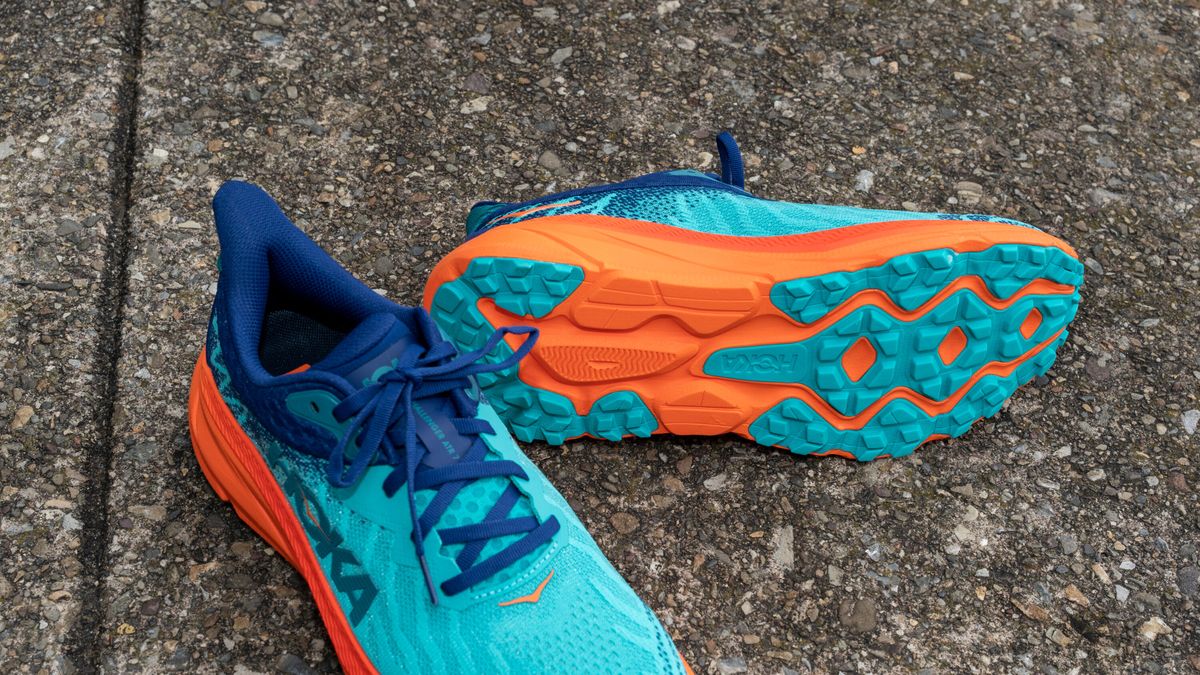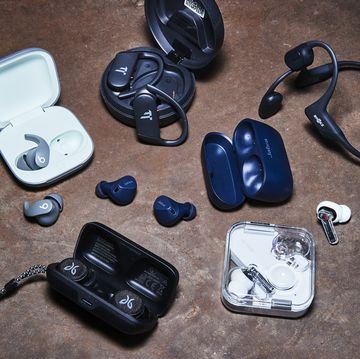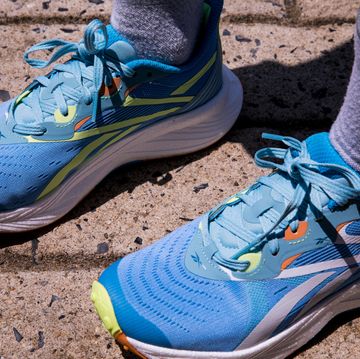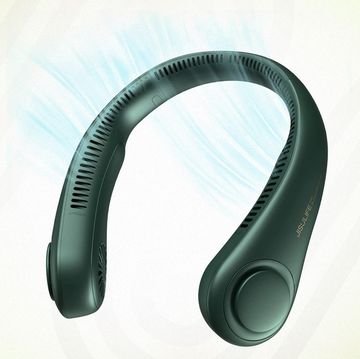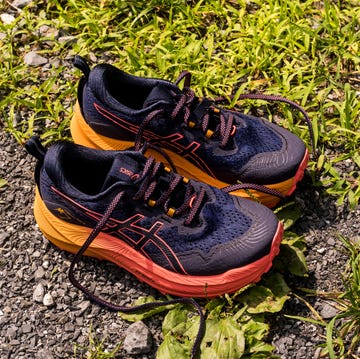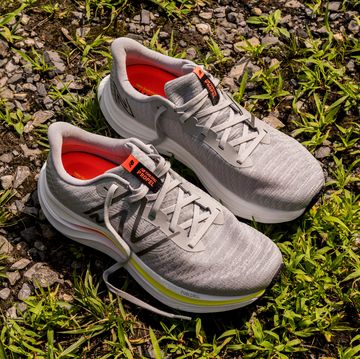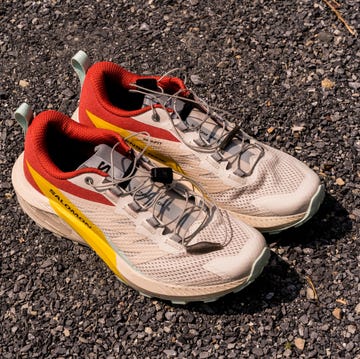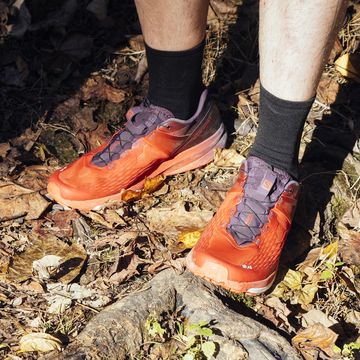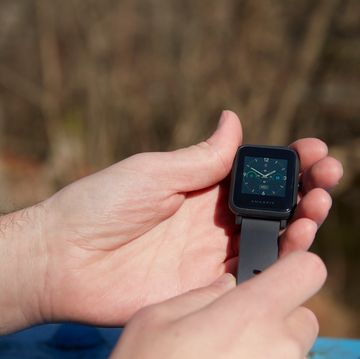For the Challenger’s massive recent update, Hoka looked at a bunch of gravel-bike tires. Why? Gravel bikes handle a party mix of terrain—everything from portions of street to dirt and mud, maybe some sidewalk, and of course, heaps of gravel. As the the brand’s door-to-trail hybrid, the Hoka Challenger 7 needed to do the same.
- Who It’s For: Runners seeking the most versatile Hoka across multiple terrains, conditions, distances, and training paces
- Preceded by: Hoka Challenger ATR 6
- For Runners Who Like: Saucony Ride 15 TR, Nike Pegasus Trail 4
- Key Features: Rockered midsole, engineered mesh upper, Durabrasion rubber outsole with 4mm lugs
- Midsole Foam: Compression-molded EVA
Hoka Challenger 6 vs. 7: What’s New?
Flip the shoe over, and the Hoka Challenger 7’s outsole really does look like a bike tire. A combination of angular and squarish lugs grip uneven and chunky terrain, while more exposed triangles of foam and tiny, tight squares near the center roll the shoe smoothly along pavement. Wide spaces between the 4mm lugs also help sluice water and shed mud more quickly.
The material itself is also now a tough, slightly sticky rubber. Testers found that the design kept trail gunk from clogging the tread, making the roads home from the trailhead feel light and easy.
One of the best updates for the seventh Challenger is its overall durability. In our testing of the Challenger’s sixth version, we saw some pretty significant early wear. The outsole rubber began to peel away from the rest of the midsole foam before we were able to put 100 miles of running on the shoe. Two of our testers experienced this in the Challenger v6.
One tester found the tread came loose around the outer edge of the forefoot (shown below). Another tester had lugs come unglued on the shoe’s medial side, closer to where his foot touched down upon landing. We have not experienced these durability issues at all in the Challenger v7.
Road to Trail to Treadmill Versatility
“I was skeptical that it would actually do well on multiple surfaces, but it passed the test,” said a tester. “[The Hoka Challenger 7] is in the running for my new favorite pair. These shoes were grippy enough for trails but didn’t feel awkward on roads. I even used them for speed intervals on the treadmill.
“The lugs could be more aggressive for really rocky and challenging technical trails, but then I suspect they would be uncomfortable on roads. Overall, I feel like the traction is the perfect compromise.”
Most of us wouldn’t go so far as to kick it on the NordicTrack with a pair of Hoka Challengers for speed day. But the shoe does feel surprisingly great on the pavement. There’s even more foam underfoot—the overall stack height goes up two millimeters—but the shoe actually has gone down in weight. That’s because Hoka’s using a tweaked formula of its midsole foam. It’s soft and not too squishy, but it’s still mostly EVA, so don’t expect an explosively bouncy ride and energetic rebound.
Performance in Adverse Conditions
In cold weather, the midsole does firm up a bit more than shoes that use TPU or Pebax-based foams. At temperatures below freezing, the rockered ride stiffens and loses some of its smooth roll from the heel to forefoot. However, it’s still far from rigid. And we still were able to achieve a good sense of the terrain underfoot. Though thick, the midsole and outsole don’t leave you feeling too disconnected from mixed trail surfaces.
“We had a mix of cold, warm, dry, and wet weather during this testing period” said Dave B., who’s been testing shoes with RW for more than a decade. “I loved the Challengers because they didn’t disappoint in any of those conditions. I ran through puddles, mud, leaves, wet grass, rocks—you name it. Not once did I feel unsteady, uncomfortable, or out of control.
“There was just enough soft (but not mushy) cushioning to absorb the unevenness of trails with some rocks, roots, or branches. However, I could still feel what I was stepping on, which gave me the feeling of being sure-footed.”
Dave has a neutral gait with a forefoot strike and tells us his arch height and foot width are about average.
What Testers Liked—and Disliked: Cushioning
We asked our testers to tell us about the qualities they most and least liked in the Challenger 7. Interestingly, the shoe’s midsole cushioning was a feature that landed in both of those categories. It will largely depend on how much softness you like in a shoe, and what types of workouts you plan to use the shoe for.
The midsole foam used in the Hoka Challenger 7 falls on the softer end of the spectrum. It feels lightweight, not too dense, and not overly mushy. But in terms of responsiveness, it’s smack in the middle of the pack. The modest bounce is more than adequate for easy days, and even dipping into a few quicker tempo workouts. For anything faster, we wanted more pep. (Luckily, there’s no shortage of race-day Hokas right now. Currently, we’re really liking the Tecton X 2 for trails and the Rocket X 2 for roads.)
“I like lots of cushioning, which is what draws me to Hoka. Unlike other Hoka models I’ve tried in the past, I was surprised at how lightweight and not ‘clunky’ these felt,” one tester said. “Though not super fast, the shoes allowed me to push off strongly.”
Another tester, who trains at an average 7:45 pace for his daily runs, liked the Challenger’s responsiveness for more relaxed efforts. He noted that the shoe felt sluggish whenever he tried to pick up the pace on gravel paths.
“What I like about this shoe the least is also what I like about it the most,” he said. “For me, it’s not a shoe to push the pace in. It’s a shoe I’d lean towards for a slower recovery run or a very long run on non-technical terrain. After my runs in the Challenger, my legs feel fresher the next day than when wearing my firmer Saucony Blaze TRs.”
